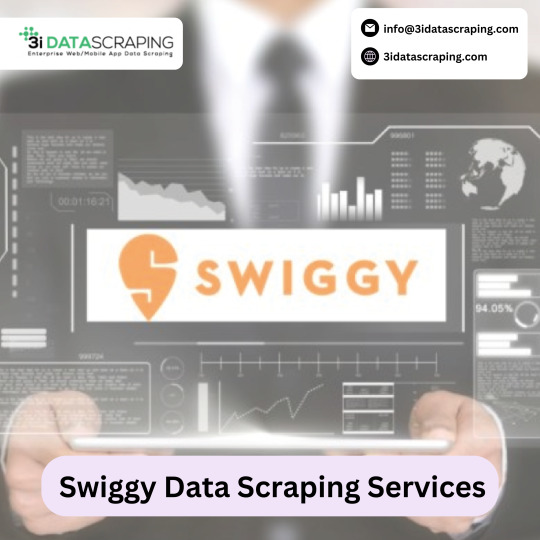#swiggyapi
Explore tagged Tumblr posts
Text

Swiggy Data Scraping Services involve extracting data from Swiggy's website, such as restaurant details, menus, prices, and customer reviews. These services use tools like Beautiful Soup, Scrapy, or Selenium to collect and analyze the data, helping businesses gain insights into the food delivery market.
0 notes
Text
Restaurant Menu Scraping – Scrape Menu Add-Ons Data
Menu Item Popularity
Data scraping can help you determine which menu items are the most popular among customers in the future menu industry. It involves tracking customer preferences and ordering patterns, which can be invaluable for restaurant owners and food businesses. Knowing which items are in high demand in the restaurant analytics sector, you can optimize your menu by promoting popular dishes or creating similar offerings. This restaurant data can also guide inventory management, ensuring sufficient ingredients for your most popular items and enhancing your understanding of the food data industry.

Add-ons and Customization Data
This involves collecting restaurant data on how customers customize their orders, such as adding extra toppings, sides, or condiments, within the context of restaurant data analytics. Understanding these preferences allows you to offer personalized menu options in the realm of restaurant market research and upsell additional items. By providing customization options that align with customer preferences and utilizing a restaurant database, you can enhance the dining experience and increase revenue.
Pricing Policies
Monitoring pricing policies involves tracking changes in menu item prices across different restaurants. This data provides insights into pricing trends, allowing you to adjust your pricing strategy accordingly. Staying competitive in the market requires understanding how your competitors price their dishes. Data on pricing policies helps you make informed decisions about your menu pricing and promotions.

Market Trends of Popular Dishes
Analyzing market trends involves identifying which food dishes are gaining popularity among customers. You can use this information to innovate your menu and stay ahead of changing tastes. Adapting to emerging menu trends can attract new customers and keep existing ones engaged. You can capitalize on current culinary preferences by adding popular dishes.
Menu Pricing & Competitor Monitoring
This use case involves tracking menu trends and pricing strategies, including the average menu prices of your competitors. It helps you stay informed about the competitive landscape in your industry, aiding in menu pricing strategies. By closely monitoring your competitors in terms of their menu trends and pricing strategies, you can quickly adapt your menu offerings in response to market dynamics. This agility can give you a competitive edge and enhance profitability in the ever-evolving restaurant industry.

Geographic Analysis
Food On-Demand & Restaurant Aggregator is a completely new way of providing food. A lot of food owners use Food Aggregator apps to help customers order online as well as dispatch food to customers’ homes or offices. With scraping data from food service aggregator services, you can easily get results with precision and on-time delivery. Our mobile app scraping assists you in getting desired product data.
Cuisine Gap Analysis
Conducting a cuisine gap analysis means assessing the availability of specific cuisines in a particular market. It helps identify opportunities for introducing new types of cuisine. Identifying gaps in the market can lead to innovative menu additions and potentially less competition in offering unique cuisines, attracting a niche audience.

Benefits of Restaurant Menu Trends & Add-on Items Data Scraping
Menu Enhancement
Analyzing data on food menus and add-on items allows you to identify gaps or opportunities in your own menu. You can expand or enhance your offerings to better meet customer demands.
New Product Development
Data on menu items and add-ons can inspire new product development. You can introduce innovative dishes or additional items that resonate with your target audience.
Customer Preferences
Analyzing menu data helps you understand customer preferences, including popular dishes and add-ons. This data enables you to tailor your offerings to meet customer demands.
Promotions and Marketing
Data on popular menu items and add-ons can inform your promotional and marketing campaigns. You can highlight these items to attract more customers.
Food Trends Identification
Scraping menu data can help you identify emerging food trends and adapt your offerings accordingly.
#datascraping#SwiggyAPI#Zomato API#youtubeshorts#foodblogger#restaurantstyle#new#technologygyan#food#grubhub API#doordash API#deliveroo API#seamless API#postmates API#foodpandadelivery API#ubereats API#justeat API#walmart API#costco API#krogercloseoutsale API#gopuff API#safeway API#amazonfresh API#instashop API#ocado API#glovo API#bigbasket API#instacart API#woltk API
0 notes
Text

0 notes
Text
Food Delivery API - Transform the Food Delivery Industry

Foodspark provides Real-Time Grocery and Food Data APIs and Restaurant Scrapers that will help you gather the data in the desired format.A Food delivery API (Application Programming Interface) is a technology that acts as a digital connector between different parts of the food delivery process. It helps restaurants, delivery services, and customers communicate and share information. It is a technology tool that makes it easy for these different platforms to cooperate.
#datascraping#SwiggyAPI#Zomato API#youtubeshorts#foodblogger#restaurantstyle#new#technologygyan#food#grubhub API#doordash API#deliveroo API#seamless API#postmates API#foodpandadelivery API#ubereats API#justeat API#walmart API#costco API#krogercloseoutsale API#gopuff API#safeway API#amazonfresh API#instashop API#ocado API#glovo API#bigbasket API#instacart API#woltk API
0 notes